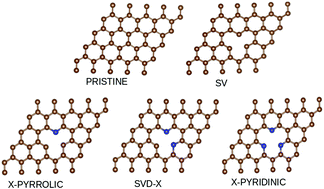Exploring doped or vacancy-modified graphene-based electrodes for applications in asymmetric supercapacitors†
Abstract
We report here density functional theory calculations and molecular dynamics atomistic simulations to determine the total capacitance of graphene-modified supercapacitors. The contributions of quantum capacitance to the total capacitance for boron-, sulfur-, and fluorine-doped graphene electrodes, as well as vacancy-modified electrodes, were examined. All the doped electrodes presented significant variations in quantum capacitance (ranging from 0 to ∼200 μF cm−2) due to changes in the electronic structure of pristine graphene. The graphene-modified supercapacitors show any appreciable effect on double-layer capacitance being virtually the same for all the devices investigated. The total differential capacitance was found to be limited by the quantum capacitance, and for all the systems, it is lower than the quantum capacitance over the entire voltage window. We found that the total capacitance can be optimized by considering an adequate modification to each electrode in the supercapacitor. In addition, we found that an asymmetric supercapacitor assembled with different doped electrodes, i.e. an F doped negative electrode and an N doped positive electrode, is the best choice for a supercapacitor since this combination results in better capacitance over the entire potential window.

- This article is part of the themed collection: Celebrating Latin American Talent in Chemistry


 Please wait while we load your content...
Please wait while we load your content...